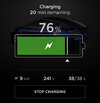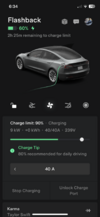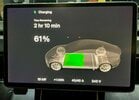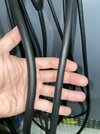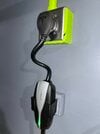I’ve had my Model Y for about 2 days now, and am charging at home with a NEMA 14-50 outlet and the “corded mobile connector” (the 40-amp version). I picked the corded model because if I come home at my latest usual time and plug in with 20%, 9.6kW will get me to 80% before my earliest usual departure time; 7.7kW on the 32A connector wouldn’t quite complete the charge in time.
I saw tonight that my car was only drawing 36A, and I was initially worried there was some wiring issue, voltage drop, etc. However, the voltage is fine even with my A/C running, and my understanding is that a wiring/reliability issue would change the amperage limit but not the maximum, and I’d see something like “36/40A” in the app and on the screen. Instead I see “37/37A” (fluctuating between 36-40A depending on when I check it). I assume this means the mobile connector is presenting to the car a lower maximum amperage?
Unplugging and reconnecting after a moment works as expected, but only raises the maximum current by an amp or two and it continues to fluctuate. Waiting a minute or so before reconnecting got us back to 40A, but only for about 30 seconds.
Before I freak out and call the electrician who wired my outlet, or call Tesla for a replacement connector, I wonder: is this normal? The mobile connector is wall-mounted and is noticeably warm to the touch; the cable to the car and outlet, the outlet housing, and the metal conduit on the wall are also warmer than ambient temperature in the garage, but only slightly so. The garage itself is not climate-controlled, and it’s probably around 80° in there. I saw the issue after about 2 hours of charging, and there are no abnormal lights on the connector.
I’m not a fan of the car charging more slowly than expected, but if this is a usual response to warm-ish temperatures in the environment, then at least it will be a mild inconvenience and not a major problem.
I saw tonight that my car was only drawing 36A, and I was initially worried there was some wiring issue, voltage drop, etc. However, the voltage is fine even with my A/C running, and my understanding is that a wiring/reliability issue would change the amperage limit but not the maximum, and I’d see something like “36/40A” in the app and on the screen. Instead I see “37/37A” (fluctuating between 36-40A depending on when I check it). I assume this means the mobile connector is presenting to the car a lower maximum amperage?
Unplugging and reconnecting after a moment works as expected, but only raises the maximum current by an amp or two and it continues to fluctuate. Waiting a minute or so before reconnecting got us back to 40A, but only for about 30 seconds.
Before I freak out and call the electrician who wired my outlet, or call Tesla for a replacement connector, I wonder: is this normal? The mobile connector is wall-mounted and is noticeably warm to the touch; the cable to the car and outlet, the outlet housing, and the metal conduit on the wall are also warmer than ambient temperature in the garage, but only slightly so. The garage itself is not climate-controlled, and it’s probably around 80° in there. I saw the issue after about 2 hours of charging, and there are no abnormal lights on the connector.
I’m not a fan of the car charging more slowly than expected, but if this is a usual response to warm-ish temperatures in the environment, then at least it will be a mild inconvenience and not a major problem.



